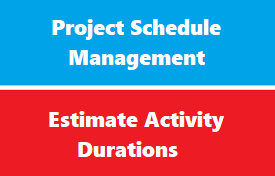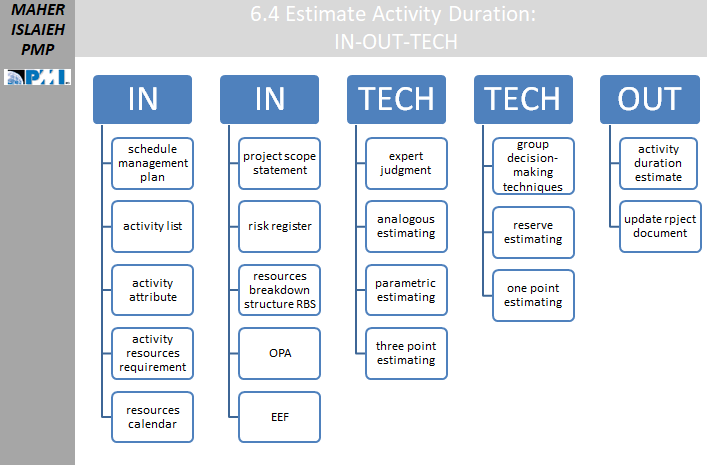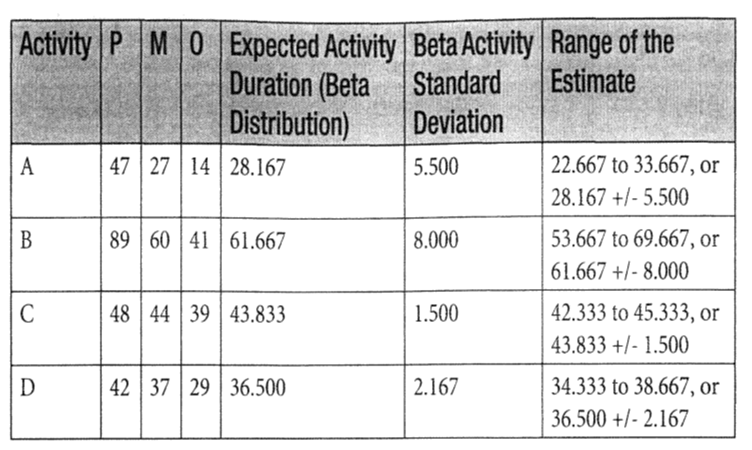introduction
Estimate Activity Durations is the process of estimating the number of work periods needed to complete individual activities with estimated resources.
The key benefit of this process is that it provides the amount of time each activity will take to complete, which is a major input into the Develop Schedule process.
Padding
Padding is extra time or cost added to an estimate because the estimator does not have sufficient information about the activity.
As we mentioned previously in first article : Padding is NOT Allowed
During this process, project resources make their estimations based on the currently available information today
And if there is not that much information about the activity, or if there are risks that may arise and cause the activity to take longer, this will cause padding during estimation.
Therefore the project manager should find ways to make each activity as clear as possible to make accurate estimates in the estimate activity durations process. Any risks might be eliminated as much as possible. Unclear points or missing information about the activities must be cleared out to have a more accurate estimation of the project resources.
process inputs-techniques -outputs
Inputs
- schedule management plan
- activity list
- activity attribute
- activity resources requirement
- resources calendar
- project scope statement
- risk register
- resources breakdown structure RBS
- OPA
- EEF
Techniques
- expert judgment
- analogous estimating
- parametric estimating
- three point estimating
- group decision-making techniques
- reserve estimating
- one point estimating
Outputs
- activity duration estimate
- update rpject document
Estimate Activity Durations: Inputs
Project Management Plan
The components of the project management plan that are inputs to this process include the schedule management plan, the scope baseline, and several of the project documents.
Let’s discuss the first two of these in the paragraphs below–the project documents are in the next section after this one (see below)
Schedule management plan
- this is the plan that is an output of process 6.1 Plan Schedule Management that gives guidelines on how to do all of the other processes of schedule management, including this process. In particular, the guidelines that help with estimating activity durations are:
- Level of accuracy–the acceptance range used in determining realistic activity duration estimates (is it done in terms of a range of values, in terms of a probability of achieving a certain deadline?)
- Units of measure–the units of measurement for measuring time (staff hours, or some other unit)
Scope baseline
- this is three documents in one, which includes the project scope statement, the WBS, and the WBS dictionary. In this process, the activity durations are added to the activities list for each work package in the WBS, and the WBS dictionary may give information on any constraints or available resources which might affect these duration estimates.
Project Documents
Activity List–contains all schedule activities required on the project which are to be estimated in this process.
This is an output of 6.2 Define Activities.
Activity attributes–contains information on each of the activities in the activity list, usually added as updates after the process 6.3 Sequence Activities. Such updates include the following:
- Defined predecessor or successor relationships between activities
- Defined logical relationships between the activities (do they have a Finish-to-Start or series relationship, or a parallel relationship as in Start-to-Start or Finish-to-Finish)
- Defined lead and lags between activities
- Other constraints that can influence duration estimates
- Assumption log–assumptions may contain information on project risks that may impact the project schedule. The assumption log is an output of the 4.1 Create Project Charter process, but can be updated after the process 6.3 Sequence Activities, and so is an output of that process as well.
- Resources breakdown structure–shows the resources potentially available for the project broken down by resource category and type. This is an output of process 9.2 Estimate Activity Resources.
- Resource calendars–the resource breakdown structure shows the resources potentially available, but their actual availability may vary during the project because they may also be used on other projects or operational work. The resource calendar identifies when and for how long identified project resources will be available for use on this particular project. This is another output of process 9.2 Estimate Activity Resources.
- Resource requirements–how do the potentially available resources meet the requirements of the activities? If someone with a higher level of skill that is normally required is not available, someone with a lower level of skill to do that same activity may require additional time, or additional resources may need to be assigned to an activity to do it in the same amount of time as it would take if the more skilled resource were doing the activity. This is yet another output of process 9.2 Estimate Activity Resources.
- Risk register–along with the assumption log, this contains information on risks which may impact resource selection and availability. For example, if you are assigning a key person to do an activity, one of the risks to consider is if they have scheduled a vacation or are going to be on a business trip when their work on the project is needed. The risk register is an output of the risk management process 11.2 Identify Risks.
Enterprise Environmental Factors
- Published commercial information on duration estimates for standard work done in the industry.
- Reference databases containing duration estimates for activities done on the project.
- Productivity metrics
Organizational Process Assets
- Duration estimates and project calendars from other similar projects (historical information)
- Lessons learned repository from other similar projects relating to how duration estimates were calculated
- Policies for creating duration estimates (usually included in the Scope Management Plan)
- Scheduling methodology (also usually included in the Scope Management Plan)
Estimating Techniques
Analogues Estimate :
- using past experience to estimate ,
- based on TOP-DOWN High level estimate
- can be applied at project level on project charter , and also can be applied on activity level (NOT recommended )
- provide understanding of management or customer expectations
Parametric Estimate
- compare two values in past and use it for estimating
- for example time per windows installation ,
- could lead to heuristic and rule of thumb
- value is NOT provided from team
Three Point Estimate (Most Common used )
- called also PERT analysis
- O >> Optimistic,
- P >> Pessimistic,
- M >>Most likely’ estimate.
- triangular distribution (simple or straight average )=(P+O+M)/3
- Beta Distribution (Weighted average ) PERT ,EAD = (P+O+4*M)/6
- beta activity standard deviation SD=P-O/6
- activity with higher standard deviation SD has higher risk
- standard deviation SD is used to evaluate offers , using procurement contract ,where SD is high we recommended to NOT use fixed-price contract , since this indicate that scope of work is NOT defined very well
- activity variance (sigma)= (P-O/6)^2
- Range Activity Estimation = EAD -+ SD
One Point Estimate
- could be based on historical information or expert judgment or even just guess
- this technique can be problematic and lead to unreliable estimate and unreliable estimator
- but its easer way to improve your understanding how to fin critical path and drew network diagram
- Could lead team to add padding
Reserve Estimating
is highly connected to risk management .
There is two reserve type:
contingency reserve
- called buffer or time reserve ,known unknown
- for risk remaining after risk plan completed to create Cost Baseline
- set by project manager based on risk estimating
management reserve
- (unknown unknown ) ,
- additional fund for unforeseen risk ,
- set by management with percentage value of total cost baseline
Estimate Activity Durations: Outputs
Duration Estimates
These are the assessments of the likely number of time periods needed to complete the activities in the activities list. I say “likely number”, because the estimates may be refined so that they are not single-point estimates, but ranges of possible results. These ranges may be expressed in terms such as 1 week plus or minus 2 days, for example, or in terms of a confidence interval, that is, an 85% probability of taking only one week.
Basis of Estimates
When going to single-point estimates to the more refined three-point estimates, you make assumptions to take the most likely estimates and come up with the pessimistic and optimistic versions of those estimates. These assumptions may come from the assumption log given as an input to this process, or they may be developed during the process itself. In addition to the assumptions made to form the estimates (which are listed in the assumption log–see “Project Documents Updates” section below), additional supporting details for the duration estimates may include the following:
- Documentation of any known constraints that may influence the estimates
- Indications of the range of possible estimates, stated in terms such as plus or minus a certain percentage, or in terms of a confidence level of the estimates (i.e., the percentage probability that the actual duration will not exceed the estimate)
- List of individual project risks influencing the estimates
Project Documents Updates
- Activity attributes–this gives details regarding the activities in the activities list. Based on the results of this process, the activity duration estimates are added to the list of activity attributes for each activity.
- Assumption log–any assumptions developed during the course of this estimate process are added to the assumption log
- Lessons learned register–any techniques that were shown to be efficient and effective in developing the activity duration estimates are added to the lessons learned register.
All of these outputs are added to the growing list of inputs to the next process, the final planning process for schedule management, process 6.5 Develop Schedule. This process will be discussed in the next post.
Project manager roles
What is project manager doing in estimating process ?
- Provide team enough information to properly estimate each activity
- Teach team how to refine their estimation
- complete check estimation
- Prevent padding
- Calculate risk reserve for activities
- Record assumption the made during estimation to be reviewed later



